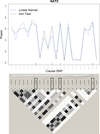Kernel machine SNP-set analysis for censored survival outcomes in genome-wide association studies
- PMID: 21818772
- PMCID: PMC3373190
- DOI: 10.1002/gepi.20610
Kernel machine SNP-set analysis for censored survival outcomes in genome-wide association studies
Abstract
In this article, we develop a powerful test for identifying single nucleotide polymorphism (SNP)-sets that are predictive of survival with data from genome-wide association studies. We first group typed SNPs into SNP-sets based on genomic features and then apply a score test to assess the overall effect of each SNP-set on the survival outcome through a kernel machine Cox regression framework. This approach uses genetic information from all SNPs in the SNP-set simultaneously and accounts for linkage disequilibrium (LD), leading to a powerful test with reduced degrees of freedom when the typed SNPs are in LD with each other. This type of test also has the advantage of capturing the potentially nonlinear effects of the SNPs, SNP-SNP interactions (epistasis), and the joint effects of multiple causal variants. By simulating SNP data based on the LD structure of real genes from the HapMap project, we demonstrate that our proposed test is more powerful than the standard single SNP minimum P-value-based test for association studies with censored survival outcomes. We illustrate the proposed test with a real data application.
© 2011 Wiley Periodicals, Inc.
Figures






References
-
- Barrett J, Fry B, Maller J, Daly M. Haploview: analysis and visualization of LD and haplotype maps. Bioinformatics. 2005;21:263–265. - PubMed
-
- Chapman J, Cooper J, Todd J, Clayton D. Detecting disease associations due to linkage disequilibrium using haplotype tags: a class of tests and the determinants of statistical power. Human Heredity. 2003;56:1831. - PubMed
-
- Cheverud J. A simple correction for multiple comparisons in interval mapping genome scans. Heredity. 2001;87:52–58. - PubMed
Publication types
MeSH terms
Grants and funding
LinkOut - more resources
Full Text Sources
Medical
Research Materials

